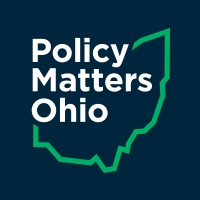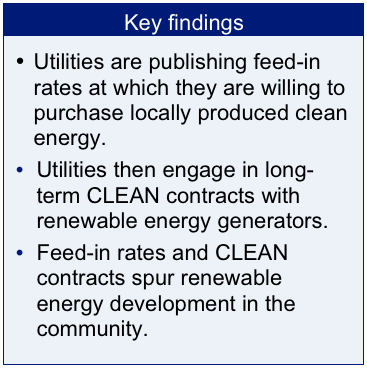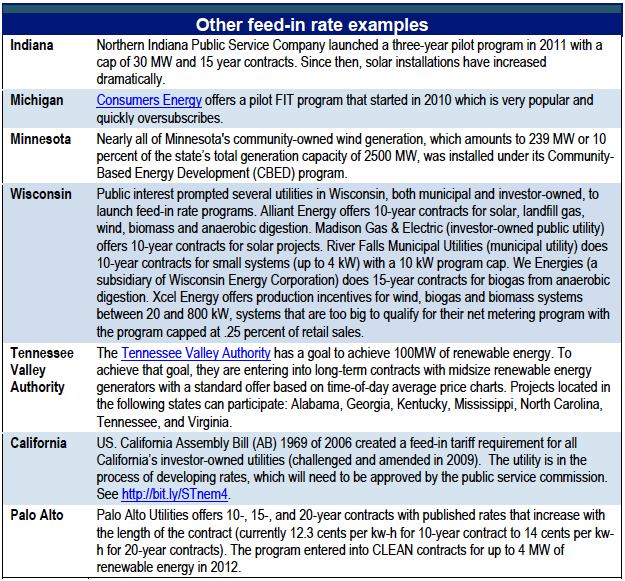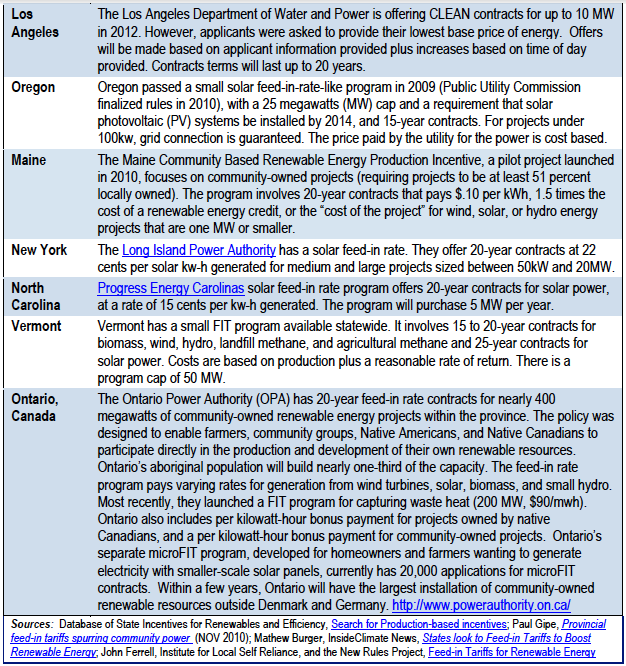
Feed-in Rates at Electric Utilities
November 21, 2012
Feed-in Rates at Electric Utilities
November 21, 2012
Download reportKey elements of feed-in rates and CLEAN contracts include cost-based, standardized contracts that are long term, which allows developers to secure project financing. Incentives for local ownership, hiring of local workers, and use of locally made products can help ensure that these approaches help grow the local economy.
Contracting for Clean Local Energy Accessible Now (CLEAN)
Background
A feed-in rate is a published rate offered by a utility company to developers of renewable energy projects to purchase the energy they produce. The utility then engages in a long-term power purchase agreement at the published rate,  called a CLEAN contract, with the renewable energy project developer. Projects developed under feed-in rates are typically developed solely for the purpose of selling that power to the grid. CLEAN contracts positively impact the community by supporting local renewable energy developers and the growth of homegrown power from clean energy resources.
called a CLEAN contract, with the renewable energy project developer. Projects developed under feed-in rates are typically developed solely for the purpose of selling that power to the grid. CLEAN contracts positively impact the community by supporting local renewable energy developers and the growth of homegrown power from clean energy resources.
How feed-in rates, CLEAN contracts work[1]
Communities first study the average costs for producing renewable energy from various sources. Since different forms of alternative energy differ in cost, the study typically determines individual costs for a broad array of technologies. For instance, the cost to produce utility-scale wind differs from the cost to develop solar power on local commercial building rooftops. Communities then use cost data to help determine adequate feed-in rates, typically based on the average cost of the technology plus a rate of return for the developer. In the above example, the rate offered to developers for rooftop solar energy might be different than the rate offered to purchase energy from large-scale community wind projects. Standardized long-term contracts are then created and signed with developers to purchase the energy they produce for a certain number of years, and utilities roll contract costs into the customer rate base. Cost data is monitored constantly.
As the technology improves over time, the cost declines and so do the rates offered by the utility. As a result, contracts entered into in year one of the feed-in rate program pay higher rates than contracts entered into in the second year. This is because renewable energy is a manufactured science, rather than a scarce resource, and as we engage in research and development and achieve economies of scale, the technology becomes more efficient, effective, and the energy cheaper to produce.
Higher rates may be offered for energy produced within the community itself, if technology is manufactured locally, or if local labor is employed. These incentives help maximize the economic value to the community of CLEAN contracts.
Key elements of feed-in rates and CLEAN contracts (TLC)[2]
Transparency: Standardized contract that is cost-based.
Longevity: Long-term 15-25 year contracts enable developers to secure project financing.
Certainty: These are “must-take” contracts. Whatever the developer produces under the contract, the utility promises to purchase. The utility offers a fixed price that declines over time depending on the contract start date. Contracts entered into today, for instance, will receive higher prices than contracts entered into in future years. This encourages project development sooner rather than later and accounts for the expectation that technology will improve over time.
Adapting feed-in tariffs to a community’s characteristics[3]
Consumer protections: For consumer protection, communities can consider capping the total program size, so that total costs of the program are clear. Since rates are published, a cap on the number of megawatts to be purchased will provide enough information to assess maximum possible cost to the consumer. Other possible consumer protection measures include capping electric rate increases, exempting low-income consumers from program costs, or refunding any rate increases to low-income consumers.
Local ownership: Communities can include a price multiplier for projects with local ownership, or create a carve-out for small projects or local ownership, such as community wind or solar.
Growing the local economy: Communities can provide incentives for the use of local workers and locally made products.
Gainesville, Florida, program spurs competition among solar developers[4]
Home of the University of Florida, with 250,000 residents, Gainesville has a municipal utility that serves both the city and the surrounding suburban area. Utility services include electric, gas, water/wastewater and telecom. Gainesville relies heavily on utility revenues, which contribute up $35 million of the city budget. The Gainesville feed-in rate program targets projects developed specifically to feed power generated into the grid. Developers are offered a flat rate that is based on expected cost to the developer plus a reasonable rate of return. 2012 contracts offered 24 cents per kilowatt-hour for ground-mounted systems and 22 cents for roof-mounted solar. In 2010, Gainesville offered 32 cents per kilowatt-hour for rooftop solar projects, and 26 cents for ground-mounted projects. Prices have dropped significantly due to competition in the community. To manage the rate impact to consumers, there is a cap on the amount of renewable energy the utility will purchase of four megawatts in 2010 and 2.7 in 2011. The line for these projects fills quickly.
Impact to the community’s energy portfolio. To start, the community’s fuel mix was 60 percent coal, 20 percent gas, 1 percent renewable, 15 percent purchased power, and 5 percent nuclear. By 2013, however, Gainesville will have drastically increased renewable energy sources to 22 percent of its total power. In addition, Gainesville will cut natural gas use in half, and implement energy efficiency reductions equivalent, saving enough energy to power 4,900 homes. While the city will continue to rely on coal for 62 percent of its energy, a slight increase from the current 60 percent, it will no longer import a large bulk of its electricity from elsewhere.
Rate impact to consumer. The customer rate impact of the feed-in rate program is $.70 per customer per month. Prior to enacting the program, the utility conducted a representative survey and found that 75 percent of customers would support solar if it cost less than one dollar per month.
Economic impact to the community. The city estimates the economic impact of their feed-in rate program includes: a $5 million investment in renewable energy by feed-in rate customers; an estimated $24 million to be spent annually going forward; 261 estimated jobs created; $240,000 to 25 owners in CLEAN contract payments; and 1,000 kilowatts in new installed solar photovoltaics in the first 16 months. There are 3.8 megawatts under construction – two large projects, one commercial-sized rooftop. Indirect benefits include location of solar companies, capital infusion, solar-friendly zoning rules, dramatic improvement in cost per watt, competition in the solar market, and a new market in leasing rooftops.
Additional resources
- Center for American Progress, CLEAN Contracts: Making Clean Local Energy Accessible Now
- See the Guide to FITs put out by the National Renewable Energy Laboratory (NREL)
- For general information and regular updates, see the CLEAN Coalition and their Local CLEAN Program Guide
- See UC Berkeley Study for Economic Benefits Of A Comprehensive Feed-In Tariff: Analysis Of The Reesa In California
[1] ICLEI presentation by Richard Caperton, Center for American Progress.
[2] ICLEI presentation by Richard Caperton, Center for American Progress.
[3] See the Center for American Progress 2011 report on CLEAN contracts, available at http://bit.ly/XC9uBN.
[4] Former Gainesville Mayor Pegeen Hanrahan, feed-in tariff panel at ICLEI conference on sustainability.
Photo Gallery
1 of 22

